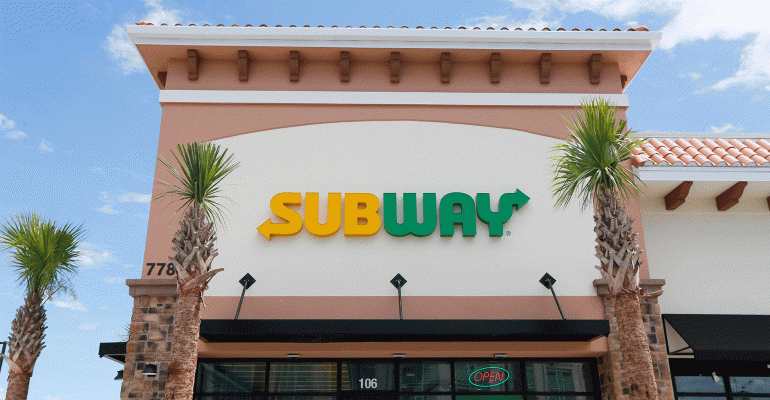Subway’s recent overhaul of its franchise agreement has roiled an already restive franchisee base, adding new technology fees, increasing existing support rates, penalizing them if they shutter units and making them subject to termination if they close for any two days in a 12-month period, according to a memo from an independent group.
The counsel for the Fairfield, Conn.-based North American Association of Subway Franchisees, or NAASF, updated members on the changes in May. In an interview Friday, one franchisee told Nation’s Restaurant News that Subway executives “have made the extortion very efficient.”
“This is the first major overhaul in the Subway franchise agreement in over 20 years, and, accordingly, for those of you who are either looking to sign new agreements for new locations or are asked to sign an agreement as part of a renewal, this is the agreement that you will be presented with over the coming year,” advised the memo, which was not intended for distribution. Nation’s Restaurant News obtained a copy of the document.
A Subway spokesperson on Friday said the quick-service franchise agreement was updated in December 2020.
"It is competitive and comparable with other franchise agreements in the QSR industry," the company said. "The contract clause regarding restaurant closures is common to the franchise agreements of most brands in the QSR industry. As was seen throughout the COVID-19 pandemic, as well as the most recent February 2021 winter storms, Subway provided substantial support to its impacted franchisees and did not act unreasonably when it came to needed restaurant closures due to these unforeseen circumstances. Our priority is always to ensure our franchisees and their restaurant employees are safe."
The memo was first reported by the New York Post, which noted that an “act of God” provision had restaurant owners “seeing red over onerous new rules they say could require them to keep their doors open even during a snowstorm, electrical outage or terrorist attack.” Franchisees would risk having their stores terminated, according to law firm Dady & Gardner, which advises the NAASF.
The new contract penalizes existing operators, the NAASF memo noted. Dady & Gardner attorneys advised franchisees that “for many of you, your current agreements contain a provision that provides that rather than sign this new form agreement, you can elect to renew under your current agreement by increasing your royalty percentage from 8% to 10%. That may be a decision or choice that you need to think through carefully given these changes.” It further suggested that franchisees consult their own lawyers in making the decision.
The Subway brand, founded in 1965, has been struggling since the 2015 death of founder Fred DeLuca, whose personal management style and peccadilloes were recently chronicled in a comprehensive Business Insider report.
The brand has seen its domestic unit count drop from 25,908 at the end to 2017, to 24,798 in 2018 and 23,801 in 2019, according to Nation’s Restaurant News research. At the end of 2020, NRN research partner Datassential put the number of U.S. Subway units at 22,177.
Because the new Subway contract bars franchisees from making “any disparaging or negative comments about Subway in any forum or on any medium,” the NAASF said franchisees are reluctant to talk about the changes.
One franchisee, on the condition of anonymity, said he suspects the company wants to reduce the number of underperforming units with the new contract, which replaces a former arbitration process for franchise closures with a penalty system. Subway has said flatly, however, that the company itself is not for sale.
The arbitration has been replaced with a “future lost royalties provision,” the NAASF memo says, which will require franchisees to pay the company “up to three years’ worth of royalties and ad funds, based on your prior year’s average, if you leave the system prematurely.”
At least in the current process, Subway offered “the optics of arbitration,” the franchisee said. “It was silly. It was stupid. It was vile. But least they had to go through the motions.
“They made this extortion very efficient,” the franchisee said.
Other new contract terms, according the NAASF advice, include:
- Required participation in the Subway gift card, loyalty and rewards programs and potential mandates for digital initiatives at the franchisees’ expense.
- Control of franchisee unit hours of operation.
- A new $35-a-month restaurant technology fee. “This same provision allows Subway to later introduce a digital technology fee to cover the cost of apps, online ordering, etc. The fees charged for both the restaurant technology fee and the digital technology fee can be increased at Subway’s discretion,” the memo warned.
- A new $200-a-month “legacy support fee” for those franchisees who do not comply with Subway’s technology standards and specifications, fail to return hardware, fail to upgrade systems, fail to allow timely access to Subway to the technology or install unauthorized software. It is subject to being increased.
- A new $155-a-month “digital menu board fee.”
- A requirement that franchisees, when they end their contract, give any furniture, signs or material that says “Subway” back to the company, even though they may have paid for it.
Update June 11, 2021: This story has been edited to include comments from Subway.
Contact Ron Ruggless at [email protected]
Follow him on Twitter: @RonRuggless
